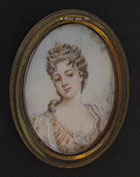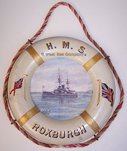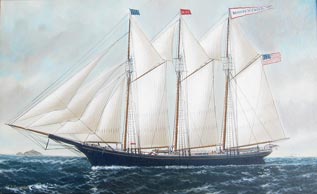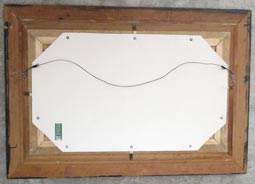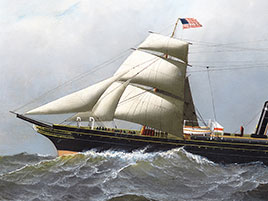West Sea
Company
FINE ART &
PRINTS
Catalog Page 1

When no price is shown, use  button to request the price.
button to request the price.
Click on photos for larger images.
Click
 for ordering details.
for ordering details.

|
|
1.36 PAINTING. James
A. Shearman, American, active New York City 1851-1888, oil
on wooden panel, “An American Cutter At Sea.”
This delightful, very tight rendering features a
sharp cutter yacht under full sail on a starboard tack in
pleasant seas, with shipping and clouds in the
background. The vessel flies the owner’s flag
from the top and the Union Jack from the spanker. Two
sailors can be seen sitting on the lee rail. This
meticulously rendered painting is executed in oil paint on a
wooden panel measuring 2 1/8 by 3 ½ inches sight.
In view of its small size the detail and execution are
superb! It is signed lower left with the artist’s
monogram with a conjoined “SH.” It is
housed in its original oak frame with fancy gilt “ropework”
liner measuring 8 by 9 inches overall. Absolutely
perfect untouched original
condition. A real delight to the eye which is perfect
for hanging in an area of limited space.

Well listed artist James A. Shearman was a marine painter,
lithographer and an engineer. He appears in the New
York City Directories as having painted from
1851-1888. His works are on display in several notable
museums. (Dorothy Brewington, “Dictionary of
Marine Artists,” 1982. Young, “Dictionary
of American Artists, Engravers & Sculptors,”
1968).
|

|
|
1.46 AMERICAN ETCHING.
Charles J. A. Wilson, American,
(1880-1965) detailed rendering of the passenger steamer
LOUISE under full steam, heading out to
sea. This precise etching is pencil titled lower
left in the artist’s own hand “Louise of
Baltimore” and is pencil signed lower right “CJA
Wilson” with his monogram just above. The
coastal steamer with early rocking beam engine and huge
smoke stack is depicted loaded with sightseers on deck as
flags and pennants proudly fly in the stiff breeze. It
is shown passing a can buoy to starboard, while a tramp
steamer is seen making the harbor entrance in the
background. This etching is done on high quality rag
paper and measures 4 ½ by 6 inches sight with an
overall dimension of 6 ¾ by 8 ¾ inches.
Perfect original condition.
295
Charles J. A. Wilson, Scottish-American (1880-1965) was born
in Glasgow, Scotland in 1880. At age one his family
immigrated to Duluth, Minnesota. As a teenager,
Wilson moved to Newton, Massachusetts where he began his
self-taught career as a painter of ships in Boston
Harbor. Early in the 20th century he was employed by
Bethlehem Steel Shipbuilding Company etching ship portraits
from blueprints. During the Second World War he served
with the United States Coast Guard in the Boston area, again
putting his artistic talents to use for the War effort.
His works are exhibited in the Pennsylvania Academy of Fine
Art, Philadelphia Museum of Art, Currier Gallery, Lyman
Allyn Museum, the U.S. Coast Guard Academy, New London
Connecticut and the Library of Congress.
The handsome sidewheel steamer LOUISE, call sign
JCMW, was a steel-hulled passenger vessel of 231.7 feet in
length with a breadth of 33 feet, a draft of 8.8 feet,
displacing 1023 tons. She was built in Wilmington,
Delaware in 1864 and operated under the ownership of Charles
Morton out of Baltimore, Maryland. In 1886 Morton sold
his interests and LOUISE was relocated to Camden,
New Jersey where she continued to ply the passenger trade
into the early 1900’s. (“Record of
American & Foreign Shipping,” 1885, American
Shipmasters Association, New York).
|


|
|
1.44 FRAMED IMAGE of the “GREAT
EASTERN.” Very handsome late 1800’s
framed oil lithograph of the most famous steam/sail liner
the SS GREAT EASTERN underway at sea. The
image looks like an authentic oil painting, even down to
brush strokes in relief! This transfer method was a
very popular way of producing realistic copies of original
oil paintings in the second half of the 19th century.
The pleasing scene depicts the giant liner from
a port quarter perspective steaming out to sea, all sails
furled, with a square-rigged ship on the horizon. It
is housed in its original, quite exceptional, carved wooden
frame with scalloped and raised borders. The back is covered
in old brown paper on with the penned inscription “From
Port Townsend Washington, Grand father’s home - April
1972 (Jack B. Lewis)”. The image measures 3
¼ by 5 ¼ sight and the frame is 6 by 8
inches. 
The SS GREAT EASTERN was an iron steam/sail ship
designed by Isambard K. Brunel which was built by J. Scott
Russell & Co on the Thames River, London. With a
length of 692 feet and a displacement of 18,915 tons, she
was the largest ship ever built when launched in 1858.
She had the capacity to carry 4,000
passengers around the world without refueling. The
GREAT EASTERN had five funnels, sharing that
number with the Russian cruiser ASKOLD.
The only ship to surpass that number of smoke stacks was
HMS VIKING, which had six.
Brunel died in 1859 shortly after the ship’s ill-fated
maiden voyage, during which she was damaged by an explosion.
After repairs, she began passenger service between Britain
and America. In 1865 she was converted into a
cable-laying ship. She had the distinction of laying
the first lasting transatlantic telegraph cable in
1866. The massive ship was broken up in 1889.
|


|
|
1.45 SHIP’s PAINTING.
Stunning, mixed media, water color on
silk portrait of the handsome cargo ship SS
CALIFORNIA steaming off the coast of Japan with Mount
Fuji in the background. This realistic and extremely
detailed ship’s portrait is signed lower right “Mr.
T. Hagawara Yokohama, Japan 1977” and is titled
lower center “S.S. “CALIFORNIA””.
It depicts the ship, with the iconic funnel marking of the
States Lines seahorse “S”, off the coast with
shoreline in view, plying the blue waters of the Japan Sea
with seagulls frolicking off the fantail. Execution of
this painting is of the highest order, in keeping with the
long tradition of expert Japanese port painters. It
measures 14 by 18 inches sight and is in absolutely perfect,
mint, untouched condition, having
never seen the light of day. It is still pinned to its
original backing paper and is housed in the original
cardboard shipping tube from the artist himself with a
French/Japanese Customs label. Ready to frame.
Rock bottom bargain price!
495
|

|

|
|
1.34 PAINTING. William
Pierce Stubbs, American, 19th century, oil on canvas, ship’s
portrait of the 3-masted schooner MORRIS W.
CHILD. This original large format rendering
depicts the vessel in a port side view at sea under full
sail. An island with lighthouse is shown on the left,
while a steamer is visible on the horizon to the
right. The handsome schooner flies the Union Jack from
the foremast, the owner’s flag from the main, a
colorful swallow tail name pennant from the mizzen and the
American ensign from the spanker aft. The artist has
lavished particular care in portraying the complex rigging
as well as deck details, including crewman about their
chores amidships and on the poop. This painting
measures 22 by 36 inches sight and is housed in its original
ornate gilt gesso frame measuring 32 ¼ by 46 ¼
inches. It is signed lower left, “W. P.
Stubbs.” Condition is excellent. The
painting has been professionally cleaned and relined,
retaining all of its original color, brightness and
detail. The ornate frame with floral designs has been
fully restored. According to a label on the reverse
this work was performed by Fynmore Studios, Boonville, N.Y.
in April 1973. Examination under black light shows
modest inpainting, primarily in the sky and on the periphery
due to stretcher bar wear, as expected of oil on canvas
paintings over 100 years old.  
The 3-masted schooner MORRIS W. CHILD, official
number 91311, call sign J.V.F.L., was built in Bath, Maine
by H. M. Bean in 1881. She had a length of 145 feet, a
breadth of 34 feet, a draft of 12 ½ feet and displaced
513 gross tons. As of 1885 her master was Captain
Torrey and her owners were J.P. Ellicot and Company,
homeported in Boston, Massachusetts. (“The
Record of American & Foreign Shipping,” 1885,
American Shipmasters’ Association).
William Pierce Stubbs was born in Bucksport, Maine in 1842
to the son of Captain Reuben Stubbs. In 1876 he was
listed in the Boston directories as a painter, and in 1877
as a marine artist. He exhibited at the International
Maritime Exhibition of Boston in 1890. He died May 15,
1909. His works are displayed in the Boston Historical
Society, Maine Maritime Museum, Peabody Museum, Mystic
Seaport Museum, Old State House Bostonian Society, Penobscot
Marine Museum, Beverly Historical Society Massachusetts,
Sailor’s Snug Harbor New York and the Smithsonian
Institution.
Provenance: This is one of three ship’s
portraits of the 3-masted schooner MORRIS W. CHILDS
commissioned of Stubbs by the Ellicot family, owners of the
vessel. By decent, it is the last to leave family
hands.
|

|
|
1.20 PAINTING. William
Chimmo, British, 19th century, watercolor on paper of the
Royal Navy frigate "EURYDICE" as titled lower center. This
lovely ship's portrait is done with incredibly exacting
detail. Chimmo was an officer in the Royal Navy and his
intimate familiarity with the rigging of sailing ships is
expertly evidenced in this work. EURYDICE is depicted
at anchor in a calm sea, with a Chinese war junk anchored
nearby and a steam/sail vessel aft on the horizon. Execution
of all details is of the highest caliber. The painting is
signed and dated lower right "W. Chimmo, Del. 1878."
Condition is original, as found with no damage. The heavy
card medium is stable and very sound, however it has toned
with age and some of the colors are slightly faded. The
image measures 11 1/2 by 15 inches sight and is
professionally matted in its original gilt liner, housed
under glass in an ornate gilt frame measuring 24 by 27 1/2
by inches. Interestingly an original printed poem entitled
"EURYDICE" is affixed to the back of the actual painting. A
photocopy was made and is now attached to the back of the
framing. An historic ship's portrait by a well listed
British artist
1395 
William Chimmo was a Lieutenant in
the Royal Navy. In 1849 he did paintings of the vessels
involved in the famous Franklin Search party in the Arctic.
In 1860 he published a work entitled Euryalus with
his own illustrations. Examples of his works are in the
National Maritime Museum, Greenwich, England and the New
Brunswick Museum, St John, Canada.
Why HMS EURYDICE, the Island
of Cowe's ghost ship, sank on March 22nd 1878 is a mystery
which has never been fully explained. Of the 366 men
onboard, only 2 survived.
The 921 ton 26-gun frigate HMS
EURYDICE was launched in 1843. She was designed to be
fast with a sleek wooden hull and broad expanse of sail, and
was considered to be one of the finest vessels in the Royal
Navy. In 1876 she underwent a routine refit at J. Whites
shipyard at Cowes, and was deemed to be in top condition
after recommisioning in Portsmouth on February 7th of that
year.
By the 1870's iron ships and
ironclads had made wooden warships obsolete on the
front-line. Accordingly EURYDICE was converted into a
training vessel. Under the command of Captain Hare she
departed Portsmouth on November 13, 1877 for a successful
cruise to the West Indies and Bermuda. On March 6, 1878 she
headed back to England.
EURYDICE crossed the
Atlantic in only 16 days. By all accounts she handled
perfectly. Arriving off the Isle of Wight on 22nd March at
1500, the Bonchurch Coastguard Station recorded, "moving
fast under plain sail, studding sails on fore and main,
bonnets and skyscrapers." By 1540 she was sailing beside
Sandown Bay.
Suddenly a great squall bore down
on the bay with blowing snow and ice. Yet, according to eye
witnesses, EURYDICE continued under full sail with
her gun ports open before disappearing in the midst of the
blizzard. Why she was sailing with open gunports has never
been resolved.
One of the two survivors stated
that Captain Hare had ordered the sails to be taken in, but
that the order was impossible to obey since blizzard
conditions reduced visibility to zero. The frigate was blown
to the southeast and capsized onto her starboard side
allowing the sea to rush in through the open gun ports. Most
of the crew were trapped as the ship rapidly
sank.
HMS EURYDICE was raised soon
after the disaster, but never recommisioned. Her bell now
hangs in St. Paul's Church, Shanklin. Gerard Manley Hopkins
composed a short poem about her:
Too
proud, too proud, what a press she bore!
Royal, and all her royals
wore.
Sharp with her, shorten
sail!
Too late; lost; gone with the
gale.
Significantly, the sinking of
EURYDICE caused the Royal Navy to abandon sail
training. From then on Royal Naval Officers were no longer
required learn how to handle and reef sail. It was a final
recognition that the days of the traditional man-o'-war were
over.
The legend of HMS EURYDICE's
haunting began on the very day she sank. On the afternoon of
the March 22, 1878 in Windsor, the Bishop of Ripon and Sir
John MacNiell were dining with Sir John Cowell when MacNiell
suddenly exclaimed, "Good Heavens! Why don't they close the
portholes and reef the sails?" When asked by Cowell what he
meant, he replied that he didn't know, but had had a vision
of a ship coming up the Channel under full sail with her
gunports open while a great black squall attacked
her.
Since EURYDICE sank, several
people have witnessed sightings of a phantom three masted
ship which vanished when approached. Many of those were
blamed on "freak reflections of light on mist". Yet in the
1930's Commander Lipscomb was in command of a submarine
which was forced to take evasive action to avoid striking a
full-rigged ship which then promptly vanished!
|

|

|

|

|
|
IMAGE
|
DETAIL
|
SUPER DETAIL
|
POEM
|

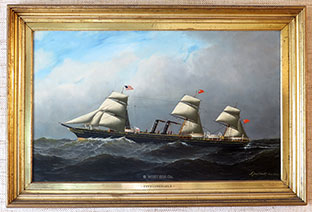
|
|
1.36 PAINTING. Charles
Rosner (1894-1975), German-American, watercolor on paper of
an iron hulled square rigger shortening sail. This
beautifully rendered painting is of the highest quality with
realistic detail. It depicts an iron-hulled square
rigger in moderate seas with another ship in the distance to
the left and a schooner on the right. It is signed “Chas
Rosner” lower right in the artist’s distinctive
hand. The 7 ¼ by 10 ½ sight painting is
decoratively French-matted in its original painted wood
frame under glass, measuring 14 ¾ by 18 ¾ inches
overall. The back bears the original framer’s
label of “Robertson- Deschamps Co. 415 Madison Avenue
:: New York,” inscribed in old ink, “Original
Drawing Chas. Rosner.” Perfect condition.
879
Charles Rosner was born the son of a doctor in Langendorf,
Germany in 1894. When the family vacationed in the
port of Kolberg, the young to-be artist became enthralled
with the ships and activity in that busy harbor.
At the tender age of 16 Rosner signed on as an apprentice
seaman aboard a square rigger for a period of 5 years,
during which time he rounded Cape Horn 5 times! With
the onset of World War I he left the sailor’s life to
take up residence in Iquiqua, Peru. It was there he
began to paint ships’ portraits. In the years
following his art was highly regarded for the
chromolithographs produced from his paintings which graced
the covers of several well known publications. Quoting one
contemporary review of the artist’s life, “To
have an original of Rosner’s work is a great stroke of
luck.” Examples of his paintings are on display
in several public institutions including Mystic Seaport
Museum.
|

|

|
|
1.38 PAINTING. Large, early
1900’s oil on canvas scene of a magnificent square
rigger under full sail passing through a straight guarded by
a castle. This handsome rendering is done in bold
colors with exacting detail, evidencing the talents of a
seasoned professional. The center subject is viewed
from the starboard bow, plowing through choppy seas as it
passes a small gaff-rigged fishing boat in the
foreground. In the background, another ship, a bark,
sails past a huge castle situated on the point, with
mountains in the distance. This realistic scene
exhibits great motion and composition. The treatment
of the rolling waves is especially nice. Indistinctly
signed, lower right, but no doubt a listed artist. It
is in excellent original condition having just been
professionally cleaned showing crisp, brilliant
colors. The canvas is original, not lined, and
exhibits a few minor patches on the reverse. This good
size painting measures 20 ½ by 30 ½ inches sight,
and is housed in its original carved and gilded wooden frame
measuring 27 by 37 inches. A great value, ready to
hang!  
|

|
1.29 PORTRAIT MINIATURE.
Late 18th century oil on ivory miniature portrait
of a lovely young woman with an open bodice in a lacey pink
dress, signed “Servet.” The
beautiful maiden is depicted wearing a tiara in her hair
with a large broach on her bosom. This amazingly
detailed painting truly captures her beauty with masterful
brush strokes depicting individual strands of her hair and
the glisten in her expressive brown eyes. Contained in
the original gilt metal oval frame under glass, the reverse
of which bears a small suspension ring for display. 3
1/8 by 2 3/8 inches. Perfect original condition
exhibiting subtle colors.
595
Prior to 1839 when the Daguerreotype was introduced as
the first form of photography, portrait miniatures
commissioned of talented artists by wealthy patrons were the
only means they had of preserving their likenesses for
posterity. Obviously these artworks were costly.
Only the aristocracy were able to indulge in such
luxuries.
|

|
|
BACK
|


|
|
1.35 PAINTING. George
Stanfield Walters, British (1838-1924), watercolor on paper
entitled on the mat lower center “Trawlers in rough
weather, G.S. WALTERS, R.B.A.” This dramatic
rendering depicts a 2-masted fishing schooner in heavy seas
with crewmen at the main hastily taking in one of the jibs
while the helmsman and captain steady the vessel aft.
The craft appears to have made a successful catch. The
aft hatch is shown full and draws the attention of a flock
of seagulls near the fantail. The upper profile of
another craft can be seen in the distance, hull down over
the horizon. This brilliant scene is signed
lower left “G.S. Walters” and measures 10 by 14
inches sight. The painting retains its original
lovely ornate gilt gesso frame and heavy gold mat under wavy
old glass. The frame measures 21 by 25
inches. The entire presentation appears to be in
pristine, untouched original condition showing good age but
no abuse. The colors are rich and bright, with the
imagery crisp. 
George Stanfield Walters was born in Liverpool in 1838,
the son of famous marine painter Samuel Walters.
George was a willing pupil and by age 15 was painting the
rigging in his father’s pictures. He became a
member of the Royal Academy, the British Institution of
Artists, and the New Watercolour Society. His works
are exhibited at the London Port Authority and the Peabody
museum, Salem, Massachusetts, among others.
|

|

|
|
1.13 PATRIOTIC 19th CENTURY
PRINT. Original late 19th century
chromolithograph of the famous engagement between American
Naval forces and the Spanish fleet in “THE BATTLE OF
MANILA.” as entitled lower center. This colorful
action-packed rendering depicts superior American forces
overwhelming the Spanish Armada in the Manila Bay,
Philippines. The resounding victory is recorded on the
bottom of the print which reads, “FOUGHT MAY 1ST BY
REAR ADMIRAL DEWEY. SPANISH LOSS 11 SHIPS. 150 KILLED,
250 WOUNDED. AMERICAN LOSS NONE.” It is
signed by the printers “NO. 1209 COPYRIGHTED 1898 BY
MULLER, LUCHSINGER & CO. NEW YORK.” This
brilliant print is as colorful and crisp as the day it was
printed, having never seen the light of day in over 100
years! It measures 16 by 19 ¾ inches. The image
is in mint, original
condition. There are some minor tears and losses to
the extreme periphery of the border which are easily matted
over. One of our best bargains ever!
95
Enrique Muller was the preeminent Naval photographer in
and around New York at the turn-of-the-century. It is
interesting that he collaborated with Luchsinger to produce
this historic lithograph of a scene half a world away.
|
|

|
|

|
|
1.32 PAINTING. J. & F. Tudgay,
British, mid-19th century, oil on canvas painting of the
full-rigged 3-masted barque “TAMAYA of LIVERPOOL”
at sea, as indicated on the stern. This classic ship’s
portrait features two views of the same vessel. The
primary view is a starboard broadside, and the secondary
view is as seen from the starboard quarter. This
beautiful scene shows the heavy-laden ship off the Needles
in the approaches to Southampton. It depicts the most
minute rigging details and deck activity. No less than
8 crewmen are shown, busily engaged in making preparations
for entering port. The helmsman is at the wheel.
This painting expertly displays the Tudgays’ intimate
knowledge of shipboard fittings and equipage. The ship
is shown flying the “Old Duster” – the
British merchant ensign, from the after mast and the house
flag of a white cross (X) on a blue field from the
mainmast. The lovely ship’s figurehead in the
form of a Victorian maiden adorns the prow with an ornate
gilt trailboard behind. In the second view the stern
of vessel is shown. The helmsman is clearly visible at
the wheel as is the very detailed stern carving. 3
other sailing vessels are shown on the horizon, departing
port in this busy shipping lane. To the right, the
Needles Lighthouse is shown, guarding the approaches to the
Solent between Britain and the Isle of Wight. This
painting is signed lower left “J & F TUDGAY”
on a barrel adrift just below the stern. This large
oil on canvas rendering measures 25 ¾ by 41 ¼
inches site and is mounted in a magnificent, very ornate
gilded gesso frame with beading and fluting measuring 36 by
51 inches. The painting has been professionally
relined on its original wooden stretcher using the original
tacks and has not been cut down. The surface
of the painting is virtually untouched, with only minimal
inpainting in the topmost sky near the frame where there was
a stretcher crease. The Tudgays' works have enjoyed a recent
resurgence in popularity, selling in the $35-45,000 range at
two recent auctions.  
The 3-masted ship TAMAYA was an iron-hulled
barque of 570 tons, with a length of 162 feet and a breadth
of 26 ½ feet, launched in Liverpool in 1862 under
ownership of Imrie & Co. (Lloyd’s Register
of Shipping 1864-1865).
J & F Tudgay (John and Frederick) were brothers who
collaborated in the painting of ships’ portraits in
England during the short period from 1857 to 1865.
Nevertheless, their output is regarded as some of the finest
produced in the 19th century. Their works are on
display in the Bremen-Staats Museum, Bremen, Germany, the
Norsk Sjøfartsmuseum, Olso, Norway and the Peabody
Museum of Salem, Massachusetts. (Dorothy Brewington, “Dictionary
of Marine Artists,” 1982, Peabody Museum of Salem,
Mystic Seaport Museum, Connecticut.)
|
|

|

|

|
|
SUPER STERN DETAIL
|
SIGNATURE
|
BACK
|
1.30 ROYAL NAVY WATERCOLOR
COMMEMORATIVE. Genuine, turn-of-the- last century
commemorative depicting the armored cruiser “H.M.S. ROXBURGH”
as fancily-painted on the lifering frame surrounding her
portrait. This lovely presentation consists of
an original watercolor painting of the vessel’s
port bow aspect at anchor in a harbor. It is signed and
dated lower left, “JSM 1904,” that being the signature of
well-listed British marine painter, James Scott
Maxwell. The painting is protected under its old wavy
glass, housed in a carved and painted wooden “lifering”
frame encircled by a braided multi-color “grab-line” of
silk. The image is flanked on either side by realistic
hand-painted images of the Royal Navy military ensign on the left and
the British national flag on the right. The reverse shows
its original wooden backing held in by old square
nails. At one time the back was covered by paper, remnants
of which remain. The painting measures 5 inches in
diameter sight. The ring is 9 inches
across. The painting itself is in untouched original
condition with only some very minor touch-ups on the ring
frame. Rarely were such presentations painted and signed
by well-known artists. This example is by
far the finest of its type we have yet seen in our 35
years! 649
HMS ROXBURGH was a Devonshire-class armored cruiser laid
down by the London and Glasgow Co. yard in 1903 and launched on
January 19,1904. She had a length of 473 ½ feet and
displaced 10,850 tons. She saw furious action in the North
Atlantic during World War I, surviving only to meet her ultimate fate
at the hands of the ship breakers in Germany in November 1921.
19th century British painter, James Scott Maxwell's work
covered a narrow subject range of warships and British scenery. His
paintings carried the signs of immense brilliance such as in
"Villefranche 188," a drawing of a fleet of ships. Most of his
paintings were small watercolors or the modest sketches of steamers,
like "Clyde," "Duchess of York," and "Ben Lomond," all carried out in
small, 7 by 9 inch frames or slightly larger.
His repertoire concentrated on seascapes of pre-World War I
British seagoing steamers and men-o-war. The works embody a form of
art known popularly as "British or Continental watercolors." The type
was more or less a technical 'photo realistic' drawing, aimed at
factual representation, rather than artistic creativity. Maxwell's
drawings of American steamships, such as "St. Paul" and "Haverford"
are such technical sketches, which are powerful attempts at
photographic realism.
James Scott seems to have been prolific from 1875 into the early
1900s, when most of his dated sketches were produced. In addition, it
seems that a majority of his works could be commissions from
steamship companies or the ships' crew members themselves. Though
more than 200 works are known to survive, there seems to be no
variation of theme, indicating that he painted only seascapes and
ships. His geographical reach was limited to port towns of the
British Isles.
|
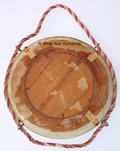
|
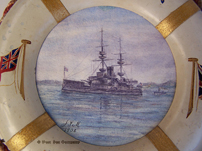
|
|
BACK
|
DETAIL
|

1.40 IMPORTANT MINIATURE PORTRAIT.
Genuine 18th century Continental oil on ivory portrait
miniature of a stately nobleman identified on the reverse in
beautiful hand-written script as the "Barone Massimiliouro De
Flercles." This handsome young gentleman with lace collar is
dressed in typical 18th C. finery. Probably of Belgium
origin. An extremely well done miniature which bears close
scrutiny under the most powerful magnification! Housed in its
original gilt metal frame 2 by 2 1/4 inches. Superb, untouched
original condition.
695
Preceding the advent of the Daguerreotype, the first form of
photography introduced in 1839, portrait miniatures such as this
example, were the only means by which wealthy patrons could insure
that their likenesses were preserved for posterity.

|
|
BACK
|

1.16 SHIP PORTRAIT. Mid-1900's ship's
painting by well listed Japanese marine artist T. Hagiwara as signed
lower left "T. Hagiwara, Yokohama, Japan, 1957." This lovely painting
with its exacting detail is a watercolor done on silk. It portrays
the famous West Coast liner H. F. ALEXANDER as titled lower center
and prominently identified on the vessel's bow. Stack markings of the
Admiral Lines, Pacific Steam Ship Co. are also quite visible on the
vessel's two funnels. This ship's portrait is a very unusual "bird's
eye view" showing the entire vessel with its upper decks from the
starboard side, as it plies the vast blue-green Pacific Ocean. 15 by
19 inches sight and housed in its original black walnut frame under
glass measuring 18 1/2 by 23 inches. Virtually mint
condition in all respects. An absolutely fabulous value at this
price! 695 
Nicknamed the "Galloping Ghost of the
Pacific Coast" the H.F. ALEXANDER was launched as the GREAT
NORTHERN in Philadelphia in 1915. She was a 9,708 ton steam
turbine passenger liner operated by the Great Northern Steamship
Company. On her first voyage from Honolulu to San Francisco she made
the transit in 3 days, 18 hours and 15 minutes, setting a speed
record that lasted for more than 40 years and garnered her nickname.
In 1917 she was acquired by the U.S. Navy and renamed USS GREAT
NORTHERN. In mid-August 1919 USS GREAT NORTHERN was
transferred to the War Department to begin service as a U.S. Army
transport under the U.S. Shipping Board. During 1919 and 1920 she
made several voyages in the Pacific and to Europe. In the brief
period from August 1921 until March 1922 she served as administrative
flagship of the U.S. Atlantic Fleet under the name USS COLUMBIA
(AG-9). Decommissioned in March 1922, the ship was purchased by
Hubbard Foster Alexander and became the namesake flagship of his
shipping company the Admiral Lines. During the next decades H.F.
ALEXANDER successfully made the passenger run between San
Francisco and the Orient. As World War II approached she was sold,
briefly to British ownership before rejoining the U.S. Army in July
1942 as the GENERAL GEORGE S. SIMONDS. In this capacity as a
troop transport the ship served until March 1946. Regaining the
name H.F. ALEXANDER, she was laid up in the Maritime
Commission's reserve fleet facility at Lee Hall, Virginia until she
was finally scrapped in Philadelphia in early 1948.
In John H. Kemble's "A Pictorial History of
San Francisco Bay," 1957, Bonanza Books, New York, a photograph on
page 149 (shown as PLATE 1) is captioned, "The high point of the
coastal liners.... In 1915 James J. Hill placed the steamers Great
Northern and Northern Pacific on the run between Flavel,
Oregon, at the mouth of the Columbia River, and San Francisco on
schedules which rivaled the Southern Pacific trains. After World War
I, Great Northern, renamed H. F. Alexander, returned to
the Pacific Coast and plied between Seattle, San Francisco and Los
Angeles during the summer season from 1922 until 1936. Faster than
Harvard and Yale, she was not an economical ship to operate, but was
literally a pace-setter for the Pacific Steamship Co."

|

|

|

|

|

|
|
SHIP
|
DETAIL
|
SIGNATURE
|
BACK
|
PLATE 1
|
PLATE 2
|

1.24 FAMOUS YACHT PAINTING. John
Hughes, British-American, (1806-1878) (attrib.) oil on artist's board
of the most famous racing yacht of them all, the Yacht
AMERICA. This dramatic rendering depicts the schooner
AMERICA under full sail slicing through waves with spray in a
stiff breeze on a port tack. She flies the American ensign from the
spanker and at least seven crewmen are visible on deck. The painter
has captured the instant in time with realistic detail down to the
mast hoops, reefing lines and decorated billet. The scene is an open
ocean yacht race with 3 other yachts on similar tacks and a 3-masted
bark in the far distance. Painted at the peak of Hughes' career, this
painting very possibly it is THE Royal Yacht Squadron's Regatta in
which AMERICA won the America's Cup in 1851. It measures 17
1/2 by 11 1/2 inches and is housed in a magnificent period antique
gilt gesso frame measuring 27 1/4 by 21 inches. Outstanding condition
in all respects.

To those familiar with yachting history the
AMERICA needs no introduction. AMERICA's genesis was
sparked by an invitation from the Royal Yacht Squadron in England for
an American vessel to participate in the Great Exhibition. Under
Prince Albert's guidance, the exhibition was to be the first World's
Fair up to that time. New York Yacht Club Commodore John C. Stevens
took up the call and set about to build the "fastest yacht afloat."
Stevens gathered a syndicate including Edwin Schuyler, J. Beekman
Findlay and Hamilton Wilkes. They commissioned yacht designer George
Steers, then working at the yard of William Brown on the East River
in New York. What they created was a yacht with clipper bow, sharp
forebody and a broad beam of 23 feet well aft. With a registered
length of 93 1/2 feet and an 81 foot main mast, the yacht displaced
170 tons. Launched on May 3, 1851, to the most critical American eye
she had particular grace. However when the tradition-steeped British
builders first saw her they were horrified!
AMERICA arrived in British waters in
July, however no races had been planned and no serious British
challenges offered. Almost as an afterthought AMERICA's
skipper, Richard Brown, suggested that his yacht be entered in the
Royal Yacht Squadron's regatta race around the Isle of Wight for an
"ordinary cup" worth one hundred guineas. The day of the race, Queen
Victoria herself, aboard her yacht VICTORIA AND ALBERT was on
hand to view the spectacle. 18 yachts were entered into the race. On
board AMERICA, were 21 men including a local pilot.
At the start of the race AMERICA was
last to get underway, but as the yachts reached The Needles for the
run home a signalman on the Royal Yacht reported sighting the
AMERICA. "Oh, indeed! And which is second?" was the Queen's
query. As the signalman again swept the horizon with his spyglass,
with a quivering voice he announced, "I regret to inform Her Majesty
there is no second." As it turns out of course, there was a second,
the gallant little yacht AURORA. But she was so far behind
that the actual time of her crossing the finish remains unclear. The
London Illustrated News reported a lapse of 21 minutes. Some 20 years
after the race the New York Yacht Club accepted 8 minutes as the
official figure.
It was a Yankee victory and a notable one
which was to profoundly shake British yachting circles for decades to
come. The "Aulde Cup" as it came to be known and later, popularly,
the "America's Cup," found a home in the New York Yacht Club for the
next 132 years!

1.18 FAMOUS AMERICAN SILKWORK. Thomas
Willis, American (worked 1875-1910), silk embroidery and oil on
canvas. This classic Willis silkwork depicts the famous New York
Yacht Club steam yacht MIRAGE. The sleek and powerful yacht is
seen from the port side underway with the New York Yacht club burgee
flying from the jackstaff, the owner's burgee of New York tycoon
Cornelius Vanderbilt flying from the mast and the American yachting
ensign aft. Adding to its fame, the MIRAGE was built by
Nathaniel Herreschoff, recognized as the greatest yacht builder in
American history! With his typically amazing detail in this delicate
medium, Willis shows the helmsman at the wheel with a skylight
binnacle leading the way. Two uniformed sailors are on deck and the
yacht's captain sits just forward of the mast. The owner (Vanderbilt
himself) and another are shown lounging in deck chairs under the
canopy aft with a steward in attendance. The vessel name "MIRAGE" is
finely embroidered as a nameboard just under the funnel. Many other
minute details are present such as the capstan forward, deck
fittings, curtained windows, whistle, lifelines, lifeboat and
lifering. Signed lower right, "T. Willis." This painting measures 18
by 31 inches sight and is housed in its original ornate gilt frame
with gold liner under old wavy glass measuring 25 by 39 inches
overall. The frame is exquisite. The oil on canvas painting bears
expected age cracilature and there are a few professionally applied
reinforcements on the back of the canvas. The silkwork embroidery is
in perfect condition with bright colors, no losses and no loose
threads. Willis' meticulous stitchery is fully visible on the back.
Overall condition can certainly be rated as excellent. Circa 1900.


Undoubtedly this mixed media ship's portrait
was personally commissioned of Willis by Mr. Vanderbilt. Cornelius
Vanderbilt III (September 5, 1873 - March 1, 1942) was born into the
wealthy and powerful Vanderbilt family, the namesake having amassed a
fortune expanding American railroads Westward after the Civil War.
Called "Neily" by his friends, the younger Vanderbilt did not rest on
his grandfather's laurels however. He was a businessman, inventor,
engineer, decorated military officer and yachtsman. Yachting was one
of Neily Vanderbilt's favorite pastimes which provided him an escape
from a busy life that included a seat on the board of directors of
several major American corporations. In 1910, he piloted his yacht to
victory in the New York Yacht Club's race for the "King Edward VII
Cup."
Thomas H. Willis was born in Connecticut in
1850. By 1875 he had perfected a technique of depicting ships using
silk thread embroidery. He moved to New York where he found a greater
market for his works. He was a contemporary of famous marine artist
Antonio Jacobsen and there is evidence that the two artists actually
collaborated on some of their ships portraits. Willis' work is
publicly displayed in a number of institutions including the
Mariner's Museum, Newport News, Virginia, Mystic Seaport Museum,
Connecticut and the Peabody Museum of Salem, Massachusetts. Many of
his works were signed with the monogram of a conjoined T and W. This
painting bears his full signature.
The fast steam yacht MIRAGE was a
wooden hull vessel of 75 feet in length displacing 30 gross tons. She
was built and launched by Nathaniel G. Herreschoff in his Bristol,
Rhode Island yard in 1900. Later in her life the yacht was
retrofitted with with gas engines. MIRAGE was still in service
as late as 1925 under different ownership. (Lloyd's Register of
American Yachts, 1925).

|

|

|

|
|
VESSEL
|
DETAIL
|
SIGNATURE
|
BACK
|

1.14 PAINTING. Important, large and
impressive marine painting by the famed ship artist Antonio Nicolo
Gasparo Jacobsen (Danish-American, 1850-1921). This spectacular oil
on canvas painting depicts the graceful steam/auxilliary sail
passenger ship APACHE underway at sea. In a portside ship's
portrait Jacobsen has captured the essence of this well known vessel
in a fresh breeze with sails furled and name pennant, house flag and
American ensign flying. As the ship plies choppy deep green seas,
puffy cumulus clouds punctuate the azure sky while wisps of smoke and
steam spill from the large solitary smoke stack. This especially
pleasing rendering is boldly signed lower right "Antonio
Jacobsen/Palisade Av. Division St./West Hoboken, NJ" and dates to
1904. It is housed in a simple wooden frame with gold liner measuring
35 by 55 inches. The painting itself measures 30 by 50 inches sight
and is on its original wooden stretcher. It has just been
professionally cleaned and relined. There is very little inpainting
in evidence under ultraviolet light. What little there is consists of
a few small areas in the sky only. There is no retouching to the
vessel itself. Excellent, ready to display condition.


The much heralded steam/sail passenger ship
APACHE was launched by William Cramp & Son Shipbuilders,
Philadelphia, PA in 1901. She was successfully operated by the Clyde
Steamship Company out of her home port of New York during a
profitable career which spanned 27 years.
Literature:
Harold Sniffen, "ANTONIO JACOBSEN The
Chesklist," 1984, The Mariner's Museum, Newport News, VA, pages
32-33, item number 31. Dated 1904.
Harold Sniffen, "Painted Ships on Painted Oceans," The Mariner's
Museum, Newport News, Virginia, 1994, full page color photograph page
133.

1.98 CHINA TRADE PAINTING. Fourth
quarter of the 19th century oil on canvas rendering of the
steam/auxiliary sail White Star Lines ship GAELIC underway in
storm tossed seas with all sails furled. This impressive starboard
side ship portrait is done with the incredible detail for which the
finest Chinese port painters were revered. The brush strokes defining
the lifelines for example are no wider than a strand of hair! The
majestic vessel's details are faithfully portrayed including two
navigators on the bridge. All standing and running rigging is
delineated and the vessel name is clearly seen on the bow. The
painting measures 16 1/2 by 23 sight. It was relined over 50 years
ago, judging by the age of the canvas, and is on its original
stretcher. It is housed in a magnificent period ornate gilt gesso
frame measuring 24 1/2 by 31 inches overall. Inspection under uv
light reveals a small amount of inpainting, primarily in the sky in
front of the forward mast and just aft of the smokestack, neither of
which is visible to the naked eye. A lovely, early ship's portrait
painted during the very brief golden era of steam and sail!


GAELIC was owned and operated by the
famed White Star Lines, parent company of the ill-fated
TITANIC 40 years later.
On July 22, 1873, GAELIC made her
first New York arrival, six months after her maiden voyage in White
Star's South American service. This story was printed in the "The New
York Times" the next day:
ARRIVAL OF THE STEAM-SHIP
GAELIC
The White Star
steam-ship GAELIC, Capt. John W. Jennings, which left
Liverpool on July 10, arrived at this port yesterday. The
GAELIC was built for the South American trade, and she has
made a few trips from Liverpool to Valparaiso. She is a freight
vessel of 2,651 tons burden, and has but small accommodation for
passengers. She was sent out to supply the place of the steam-ship
REPUBLIC in carrying the weekly mails to Liverpool on
Saturdays. It will be remembered that a month or two ago the
REPUBLIC met with a serious accident, which caused her to lay
up for repairs. The GAELIC will leave this port on Saturday
next with the mails.
Interestingly, a
transcription of a U.S. Supreme Court case from 1889 documents that
fact that the GAELIC made passage(s) to China where this
painting was made:
U.S. Supreme Court CHAE CHAN PING v.
U.S., 130 U.S. 581 (1889) 130 U.S. 581
CHAE CHAN PING v. UNITED STATES.1
May 13, 1889
This case comes
before us on appeal from an order of the circuit court of the United
States for the Northern district of California, refusing to release
the appellant, on a writ of habeas corpus, from his alleged unlawful
detention by Capt. Walker, master of the steam-ship Belgic, lying
within the harbor of San Francisco. The appellant is a subject of the
emperor of China, and a laborer by occupation. He resided at San
Francisco, Cal., following his occupation, from some time in 1875
until June 2, 1887, when he left for China on the steam-ship
GAELIC, having in his possession a certificate in terms
entitling him to return to the United States..."

© 1998-2014 West Sea Co. All
rights reserved.
![]() for ordering details.
for ordering details.




